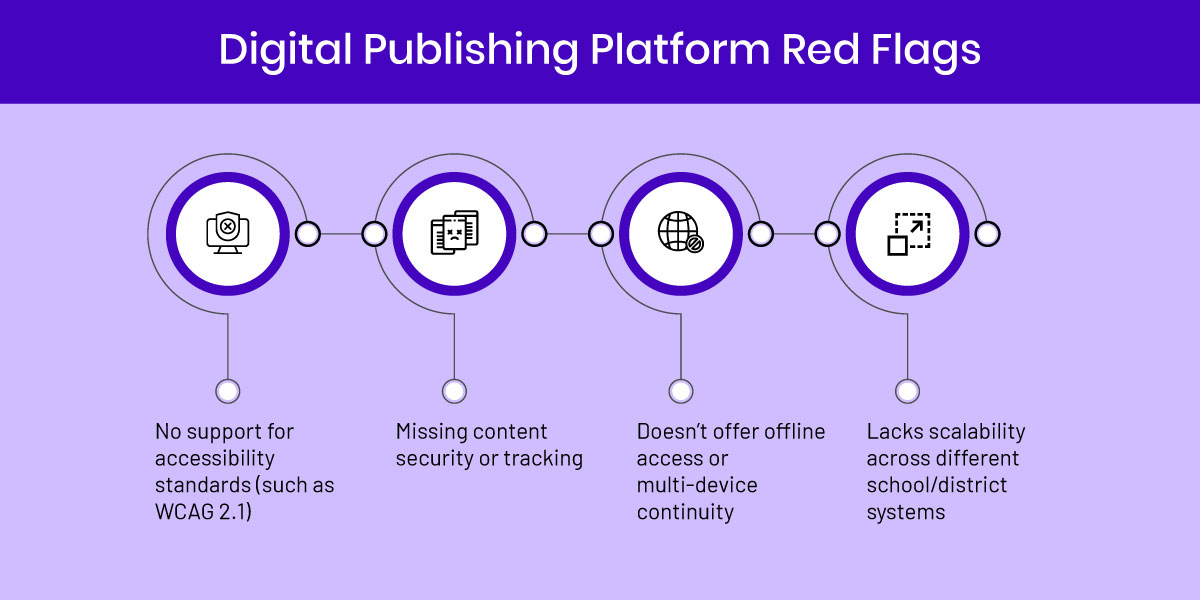What Should K-12 Content Providers Look for in a Digital Publishing Platform?

The global digital education market is anticipated to expand at a whopping 31.5% CAGR from 2025 to 2030. While the shift to the digital is on and brimming with opportunities, are you choosing your digital transformation smartly?
Imagine you invest heavily in a new digital publishing platform, only to discover it’s only a beautifully rendered facade. It lacks the classroom insights teachers need and fails to meet critical accessibility standards for diverse learner needs. If that wasn’t enough, it also doesn’t offer seamless integration with existing school rostering systems. You reckon a significant setback in a rapidly evolving educational landscape has just set in. It dawns on you that this isn’t just about missing an opportunity; it’s also about staying behind in school and district adoptions. Choosing a digital learning platform today is more than ticking boxes on a checklist. It is imperative to future-proof your educational content, empower educators, and meet the needs of the new generation of learners. This guide lays down all that you need to know.
From Static to Smart – Rethinking Publishing
First, it is time to stop treating online learning materials like glorified PDFs. Digital publishing software solutions should do much more than simply replicate print materials in digital formats. The best digital publishing companies already recognize the power of digital learning resources in engaging learners and enhancing academic achievement. Interactive, personalized, and analytics-driven experiences are key to revolutionizing learning. You need dynamic educational tools that tailor learning materials to individual student needs and provide valuable insights to educators.
The 7-Layer Cake – What Really Matters in a Platform
Choosing the right platform is like baking, a complex process with delicious outcomes. It’s much like a 7-layer cake, each with a distinct flavor, that has to be well thought through for a truly satiating outcome. Here are the key, often unexpected, ingredients that all K-12 publishers must have in their pantries:
Content Fluidity
Your chosen platform should allow for seamless updates and versioning across devices. This translates into the ability to push out crucial curriculum updates or correct a factual error across every student’s device instantly without any disruptions, such as new downloads or re-issues.
User-Centric Design
All users—teachers, admin, students, parents, and decision-makers—demand intuitive interfaces. If users find the digital publishing platform inconvenient to use, even the most brilliant content will fall flat. Design should prioritize ease of use and engagement for all users. Intuitive interfaces and immersive instructional mechanisms and activities are key to delivering such experiences.
Classroom Readiness
The best online publishing platforms are classroom-ready by design. They continuously capture user, learning, and progress data to offer insights into student engagement and performance. Choose a digital learning platform equipped with robust engagement tools, such as interactive quizzes and discussion forums, along with teacher dashboards that offer a holistic view of classroom progress.
Standards Alignment Engine
Innovative digital publishing platforms include tagging tools that allow you to easily align your content to state and national standards. This makes finding specific resources for each learning objective effortless for teachers and learners. AI learning assistants, such as MagicBox’s KEA, take away all the guesswork from content search. Also, forget manually auditing learning materials or building compliance on top of content; compliance is embedded within the authoring process.
Integration Superpowers
Since seamless integration with existing school systems is non-negotiable in the interconnected online learning ecosystem, MagicBox ensures that educational publishers do not have to worry about it. MagicSync is an integration platform that enables single sign-on (SSO) and no/low-code integrations with rostering tools, such as Clever and Classlink. It also offers robust integration with popular learning management systems (LMSs), such as Canvas and Google Classroom.
Rights & Revenue Protection
Piracy is a prominent problem across digital ecosystems. Safeguarding your intellectual property is paramount. Digital publishing platforms with strong digital rights management (DRM) tools, flexible licensing models, and effective monetization controls are critical to protecting your revenue streams.
AI-Assist Capabilities
AI dominates the future of education. Digital publishing services must be equipped with comprehensive learning analytics. Look for solutions with smart authoring tools to streamline content creation, personalized recommendation capabilities for students, based on their learning patterns, and AI-driven insights into individual student progress. Take a free trial of MagicBox’s AI-powered workflows to experience what we are talking about.
Red Flags You Shouldn’t Ignore
If your platform exhibits any of the characteristics mentioned below, it’s time to look for a better digital publishing platform.


It’s Time To Go Beyond Publishing
Visionary K-12 publishers aren’t just delivering content; they’re shaping learning ecosystems and impacting the educational outcomes of millions of students. Employing the right digital publishing platform as a strategic partner helps drive engagement, personalize learning, and enable educators to empower the next generation. By choosing wisely, you can move beyond simply digitizing and truly unlock the transformative potential of digital educational materials.
Still wondering how to choose a digital publishing platform smartly? Get expert guidance from MagicBox.

